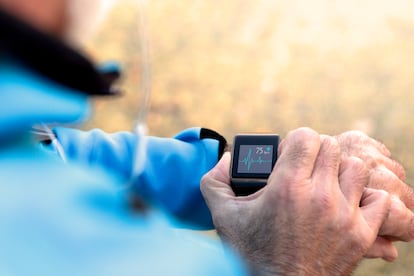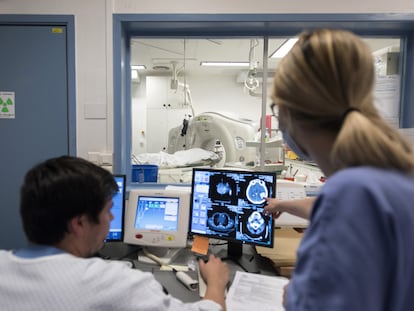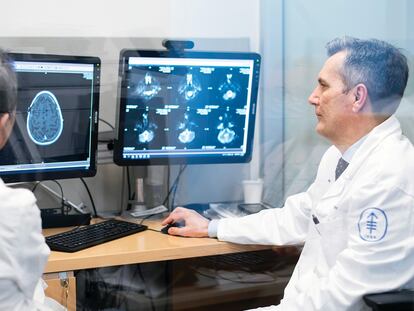Smartwatches can detect Parkinson’s years before diagnosis
Accelerometers record subtle changes in movement and sleep patterns, and this information could anticipate the disease long before it becomes evident

Before the onset of Parkinson’s disease becomes apparent, patients begin to write with smaller and smaller letters. Even before they themselves realize it, they hold down the cellphone keys longer when they send a message. And several years before the diagnosis, the first movement disorders occur. By the time the doctor diagnoses Parkinson’s, 60% or more of the neurons that produce dopamine have stopped doing so, making tremors, muscle stiffness, depression tremendously evident. Now, an investigation of thousands of people who wore smartwatches has been able to anticipate who will have Parkinson’s long before it becomes evident.
Since 2006, a study has been underway in which the U.K. health authorities have been monitoring the health of half a million people over the age of 40 (UK Biobank). A decade later, 103,712 of them were given smartwatches to record their activity for a week. These data have allowed a group of scientists to investigate something that science is eager to find: an objective marker of Parkinson’s that can be used for early detection. When they put the watches on, 273 of the participants had a clinical diagnosis of Parkinson’s. And since then, another 196 have been diagnosed. The data from these two groups have been key to detecting the abnormal signals that indicates that something is wrong in the substantia nigra, the part of the brain that degenerates as the disease progresses.
“Parkinson’s is a neurodegenerative movement disorder characterized by slow disease progression,” recalls Cynthia Sandor, a researcher at Cardiff University in the United Kingdom and co-author of the study. “Affected people experience motor symptoms such as slow movement, stiffness, coordination difficulties and tremors,” she adds. All these prodromes — signs that precede the disease — appear long before its diagnosis. “They can present subtle motor or non-motor symptoms that often go unnoticed by the person themselves.” But the accelerometers, magnetometers and gyros that are found in movement-tracking devices and smartwatches are able to pick them up. In theory, cellphones also have this technology, but as they are not always carried by a person, the records would be invalid.
In the study, the researchers relied on the data offered by a smartwatch’s accelerometer. This sensor registers the acceleration, the beginning of each movement, and is represented in a three-dimensional system that changes with each second. To distinguish distinctive patterns in the thousands and thousands of resulting graphs, the scientists used an artificial intelligence system. The results of the study, which have just been published in the scientific journal Nature Medicine, show a decrease in mobility between 7 a.m. and 12 p.m. in people diagnosed with Parkinson’s when they put on the smartwatches. Artificial intelligence was able to differentiate this pattern from the more than 40,000 people in the control group.
With that training, the researchers went further, also identifying nearly 200 people who were diagnosed an average of 4.33 years after their movements were recorded. In some cases, detection occurred up to seven years earlier. “We show that a single week of captured data can predict events up to seven years in advance. With these results, we could develop a valuable tool to help in the early detection of Parkinson’s disease,” says Sandor, who is also the head of the Institute for Dementia Research in the United Kingdom. Data from smartwatches is easily accessible and, in the U.K., a third of the population already uses the device. A platform would have to be set up to centralize the data, and the researchers were aware that this poses a technological challenge and also has legal and privacy implications. But there is no cure for Parkinson’s and all the treatment to stop its progress have failed.
Francisco Grandas, a Parkinson’s expert at the Gregorio Marañón Hospital in Madrid, points out that all the treatments available are symptomatic: they improve the patient’s condition, “but do not prevent its progression.” He also says that there are several trials of drugs in the experimental phase, which are intended to slow down the disease’s progress, but so far have not succeeded. “In addition to problems such as the one posed by the blood-brain barrier [the membrane that protects brain tissue], we suspect that it may be because the moment has already passed, because the disease is already in an advanced phase,” Grandas explains. That’s why he is optimistic about the new research. “Other markers are being investigated, such as brain imaging, lifestyle, blood biochemistry... Non-motor symptoms appear years before, but now we are beginning to learn that there are also subtle motor signs and systems for analyzing these movements could detect them,” he says. This would open the possibility of using experimental treatments in the prodromal phase of the disease.
Sirwan Darweesh, from the Department of Neurology at the Eramus University School of Medicine in Rotterdam (The Netherlands) has spent years studying the onset and evolution of Parkinson’s. In 1990, researchers from the university began a very ambitious study to follow the health of all the inhabitants over 55 years of age in Ommord, a neighborhood in the Dutch city. Within this work, Darwesh focused on a hundred people who ended up being diagnosed with Parkinson’s. Based on his research, Darwesh can say that “the pathology of the disease begins more than two decades before a clinical diagnosis can be made. The first symptoms usually appear 10 years before diagnosis.” Darwesh agrees with Grandas that Parkinson’s is being diagnosed too late: “Disease-modifying therapies are ineffective in the clinical phase of Parkinson’s. The likely reason is that the pathology of the disease is already too advanced at that stage, as more than 60% of the key dopaminergic brain cells have already been depleted by the time the diagnosis is made.”
One of the weaknesses of the new research is that the smartwatches only recorded activity for a week, but if it were applied in a real environment, the collection of data over time could refine the warning signals. Before Sandor’s current work, a group of scientists in the United States used artificial intelligence to detect patterns in data from smartwatches. They also used the sample from the UK Biobank, but they started with the data of patients who had already diagnosed with Parkinson’s. One of the authors of this research is neurologist Karl Friedl. For him, a full week of sampling movement patterns is enough “to be able to detect someone who is going to have Parkinson’s.” From a broader point of view, “we can help people discover many important characteristics of their health and well-being through the way they move,” adds Friedl. “If we add to it all the other prodromal features that are emerging related to Parkinson’s [anosmia, REM sleep disturbance, depression], the predictive algorithms in our new AI world will become very powerful,” he concludes.
Indeed, the smartwatch study also obtained data on sleep patterns, in this case using a sample of 65,000 people. Again, artificial intelligence was able to detect a decrease in the duration and quality of sleep, both in those diagnosed with Parkinson’s when their activity was recorded and in those who were diagnosis years later. “The smartwatches tell us that people wake up more frequently at night and experience longer sleep duration several years before a Parkinson’s diagnosis,” says Sandor. Combined with daytime and nighttime data, the accelerometers could give doctors time to try to curb the disease.
Sign up for our weekly newsletter to get more English-language news coverage from EL PAÍS USA Edition
Tu suscripción se está usando en otro dispositivo
¿Quieres añadir otro usuario a tu suscripción?
Si continúas leyendo en este dispositivo, no se podrá leer en el otro.
FlechaTu suscripción se está usando en otro dispositivo y solo puedes acceder a EL PAÍS desde un dispositivo a la vez.
Si quieres compartir tu cuenta, cambia tu suscripción a la modalidad Premium, así podrás añadir otro usuario. Cada uno accederá con su propia cuenta de email, lo que os permitirá personalizar vuestra experiencia en EL PAÍS.
¿Tienes una suscripción de empresa? Accede aquí para contratar más cuentas.
En el caso de no saber quién está usando tu cuenta, te recomendamos cambiar tu contraseña aquí.
Si decides continuar compartiendo tu cuenta, este mensaje se mostrará en tu dispositivo y en el de la otra persona que está usando tu cuenta de forma indefinida, afectando a tu experiencia de lectura. Puedes consultar aquí los términos y condiciones de la suscripción digital.











































